FORCE AND LAWS OF MOTION
Force and Laws of Motion is the chapter of Physics that covers the basic idea of Force with complete syllabus of class 9 with example and some numerical
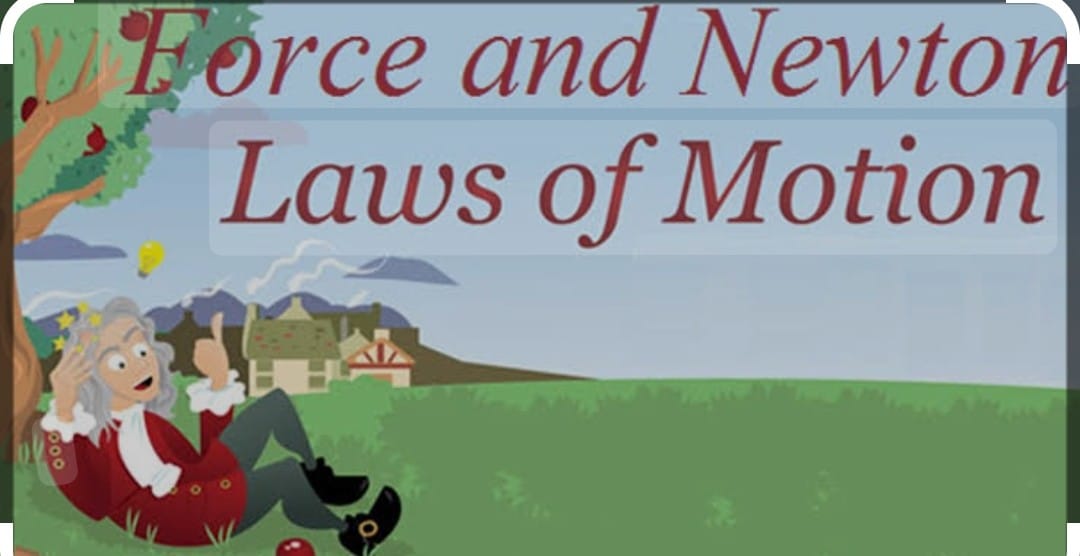
FORCE ;
It is the force that enables us to do any work , to do anything. Force is push and pull of the object.
Example to closing / opening the door , pulling of drawers .
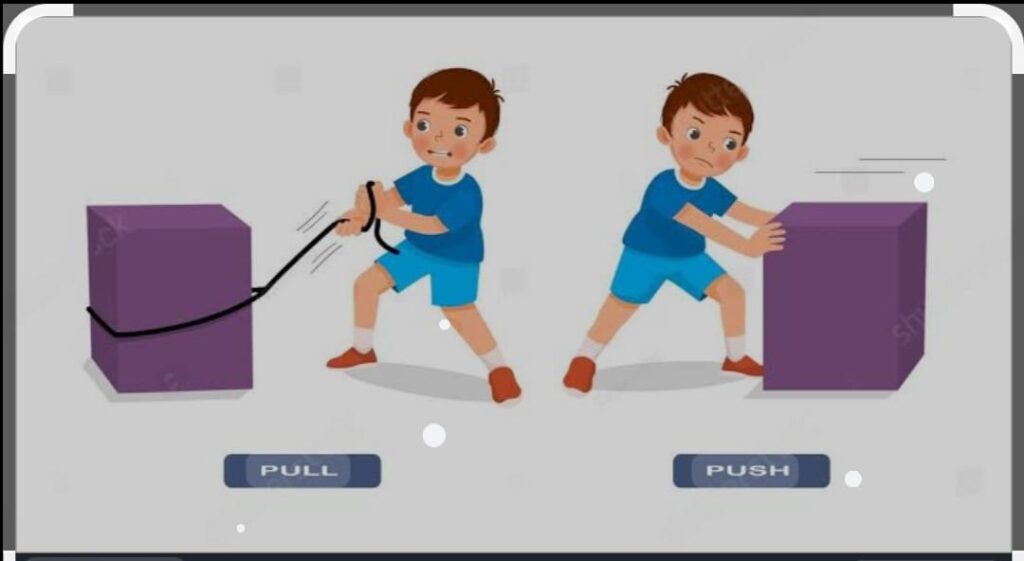
EFFECTS OF FORCE:
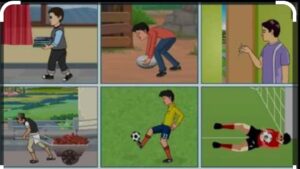
a) Force can move a stationary body /object .
b) Force can stop a moving body .
c) Force can change the direction of moving the object
d) Force can change the seed of a moving body.
e) Force can change the shape and size of the object
FORCE ARE OF TWO TYPES:
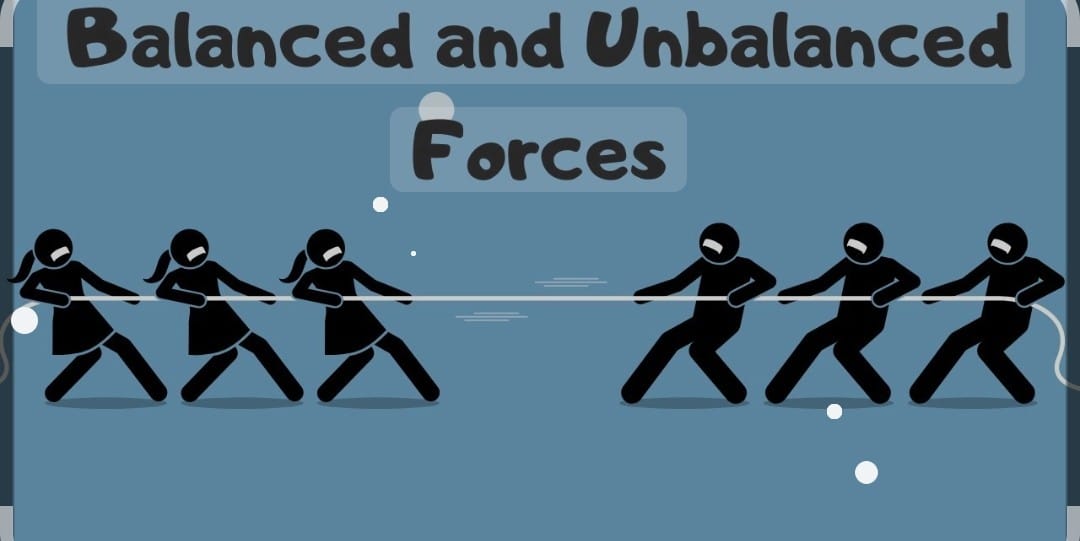
A) Balanced Force : If the resultant of applied forces is equal to zero is called balanced force .
eg a) In the tug of war if both the team apply similar magnitude of force in opposite directions, rope does not move in either side. This happens because of balanced forces which resultant of applied forces becomes zero .
b) Balanced forces do not cause any change of the state of an object the balanced forces are equal in magnitude and opposite in directions .
c) Balanced forces can change the shape and size of the objects When forces are applied from both sides over a balloon , size and shape of balloon is changed.
B) UNBALANCED FORCES ;
If the resultant of applied forces are grater than zero, the forces are called unbalanced forces An object in the rest can be moved because of applying unbalanced forces
eg it can move a stationary object , it increase the speed of moving object , decrease the speed of a moving object , stops of a moving object or change the shape /size of the objects
NEWTON’S LAW OF MOTION ; Newton studied the idea of Galileo and gave the laws of motion.
Newtons First Law of Motion :
The object remain in the state of rest or state in uniform motion along with the straight line until external force is applied .
Explanation : If any object is in rest it will remain in rest until external force is applied or if body is moving with uniform motion in straight line unless external force is applied.
First Law in Everyday life :
a) A person standing in a bus falls backward when the bus start moving suddenly this happens because the person and the bus both are in rest but when it start the in contact with the surface of bus start moving but upper portion of body is still in rest so if falls backward . In the same way if bus stops than the lower part of body stops instantly but upper portion remain in motion so it fall ahead .
b) Before hanging the wet clothes over laundry line, usually many jerks are given to the clothes to get dried quickly. Because of jerks droplets of water from the pores of cloth falls on the ground and reduced amount of water from the pores help to dry up .
MASS AND INERTIA :
Inertia is the property of the object because of which resist a change in it’s state is called Inertia .Inertia of an object is measured by mass .
Inertia is directly proportional to mass This means inertia increases with increase in mass and vice versa . A heavy object will have more inertia or lighter the object less the inertia In the other words the natural tendency of an object the resist the change in the state of motion/ rest of the object is called Inertia .
Since a heavy object has more inertia thus it is to push/pull a heavy box over the ground than the lighter one so greater the opposing force is needed to stop a heavy body than the light object
MOMENTUM :
Momentum is the quantity of motion of an object equal to the product of velocity and mass is called the momentum.
Momentum is denoted as p = mass x velocity
p= m ×v SI unit is kg – m/sec
Momentum is related with mass and velocity It means that momentum of a moving body is directly proportional to mass and velocity . Grater the mass greater the momentum if velocity is constant . If mass is constant higher the velocity higher the momentum
Example
a) when a body of 10 kg moving with the velocity of 2 m/sec momentum is ( mass. velocity) = 10×2 =20 kg m/sec .
b) A lorry of mass of 4000kg having 2000 kg mass in it moving the velocity of 2 m/sec
Total mass = 4000+ 2000 = 6000kg
momentum = mass. velocity = 6000×2= 12000 kg m/sec
SECOND LAW OF MOTION :
Rate of change of momentum of an object is proportional to applied unbalanced force in the direction of force.
Derivation of the law
mass of a body= m
initial velocity =u
final velocity =v
change in velocity = v-u
r change of momentum = mass. (change in velocity )
p1- p2 = Δ p = m(v-u) as we know a=(v-u)/t
rate of change of momentum =Δp÷ t
rate of Change of Momentum = m(v-u)÷ t
rate of change of momentum = m× a =F applied force
SI unit of force is Newton :
It is the force applied to 1kg of a body such that acceleration produced is 1 m/sec²
Newton First Law on the basis of Second Law :
According to first law of motion that the body will remain in rest or will continue moving in the straight line with the uniform motion unless the external force is applied.
Rate of change in momentum is equal to force
F= m.(v-u)/t
=>if F=0= m.(v-u)/t=0
=> m(v-u)=0
=> v-u=0
=> v=u (no change in velocity) moving with same velocity if u=o than v=0 means body remain in rest .
THIRD LAW OF MOTION :
To every action there is equal and opposite reaction .
common application ;
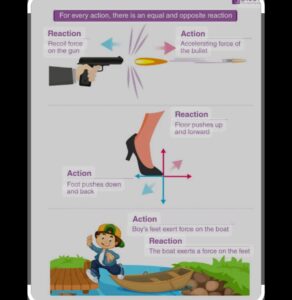
It helps us to walk on the floor, the boat moves back when we deboard , recoils of gun , rowing of boat .
LAW OF CONSERVATION OF MOMENTUM :
When two /more bodies act upon one another, their total momentums remain conserve provided no external forces are acting
Initial momentum before impact = final momentum after impact
Suppose two objects A and B each of mass Ma and Mb are moving with the initial velocity is Ua and Ub strike each other for time t and start moving with the velocity of Va and Vb respectively
Initial momentum A = MaUa
Initial momentum of B = MbUb
Final momentum A =MaVa
Final momentum of B = MbVb
Rate of change of momentum A , Fa = Ma(Va- Ua)÷ t
Rate of change of momentum of B Fb= Mb(Vb- Ub) ÷ t
According to III rd law of Motion Fa= -Fb
Ma(Va- Ua) ÷ t = Mb(Vb- Ub) ÷t
Ma( Va- Ua) = Mb(Vb- Ub)
Ma Va – Ma Ua = Mb Vb- Mb Ub
Ma Va + Mb Vb = Ma Ua + Mb Ub
Initial Momentum = Final Momentum
Example
a) A bullet of mass of 20gm is fired with the velocity of speed of 150 m/s from a pistol of mass of 2 kg
the velocity of recoil of gun by using formula
m1u1 +m2u2 = m1v1 + m2v2
m1= 20 gm= .02 kg m2=2kg u1=u2=0 v1= 150 m/s v2 ?
( m1+m2) u1= m2v2 +m1
=> ( .02+2) x0 = .02×150 + 2 x v2
0 = .02×150 + 2v2
=> v2= – .02×150 ÷ 2 = – .01×150= – 1.5 m/s
Conclusion : Force and Laws of Motion
Force and laws of Motion are the basic concept in physics that explain how the object interact with each other . The three laws of Newton are the main understanding the behaviour of objects in right way. Newtons First law the state of body when no force acts on it, second law tell about force and third law tells about action and reaction by this it makes easy to predict the motion of body in various situations from daily life to complex one.
Read More: Motion in straight Line
Read More : Gravitation
Follows Us on: Facebook